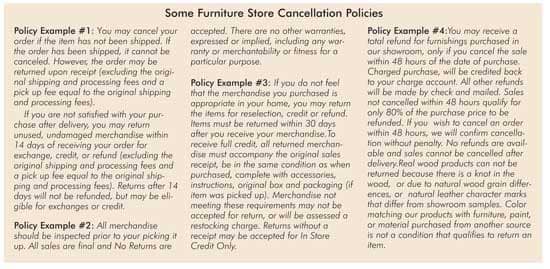Buyer’s remorse is a costly headache for furniture retailers. But you don’t have to “take two aspirin” and live with the pain.
by Dan Bolger
Buyer’s remorse is a fact of life for furniture retailers at every price point and in every area of North America. Most customers go through some sense of regret after they’ve made a significant purchase.
Buyers remorse refers to the emotional response by the consumer after a purchase is made. The higher the price and the higher the involvement in a purchase, the higher is the potential for buyer’s remorse. But it is all relative. To the recent college graduate furnishing an apartment with her first new furniture, purchasing a $999 sofa might be a real big deal while the stockbroker might think that’s pocket change. It’s all in the mind of the beholder.

Yet, most furniture retailers still like to look the other way and pretend that this doesn’t happen or doesn’t have that much of an impact on their business — let alone measure it. Don’t be fooled. Buyers remorse is real and if you don’t pay attention it can really hurt your bottom line and the customer relationship. My extensive data base of delivery metrics indicates that 2% to 10% of furniture deliveries result in a return or exchange when there is absolutely nothing wrong with the furniture. This fact points to an opportunity for many furniture retailers to improve their business.
The inset on the next page shows the extremes of typical returns policies. Nevertheless, most retailers should and do go beyond their own policies as a good will gesture. Please keep in mind that states may have differing consumer protection laws covering specific categories of merchandise. A good online resource where you can review the return policies of a number of stores including a couple of furniture stores is www.storereturnpolicy.com. You can also just google the words “store return policy furniture” and you will come up with return policies for many hundreds of home furnishings retailers.
Before The Delivery
Collecting sufficient information at the point of sale has been shown to reduce the percentage of returned merchandise. Your sales people should, therefore, be your first line of defense.
A sales culture that emphasizes the salesperson’s role in helping customers to buy, rather than try to sell them whatever is on sale or in stock, is the first step toward warding off buyer’s remorse. It makes intuitive sense that if some care has been taken to ensure that the furniture you sell is appropriate for your customer’s space and lifestyle, they will be happier.
Make sure your salespeople don’t neglect to ask the right questions about the customer’s neighborhood and their home, condo or apartment, keeping in mind that delivery access is essential.
You can eliminate the hassle of trying to deliver a very large armoire that is wider than the doorway, hall or elevator, or can’t be maneuvered up a stairway. Your sales staff training must include this critical area.
It is obvious that a failed delivery will result in a return, but a delayed or difficult delivery can cause your customer to question his or her judgement in purchasing an item or even the decision to do business with your store. Everything about the purchase can be tainted with negative emotion, resulting in lost future business, damaging social networking comments or an immediate return.
Tip: create clever signage that can be placed on large pieces to remind customers to tell sales associates about potential obstacles to delivery such as narrow stairways, doorways, etc.
The typical direct cost to do an exchange after an initial delivery is five times the original delivery cost. Since the product’s original packaging is usually gone, there will also be additional costs for protecting the product until it can be sold. Circumstances may require the product to be sold as used with further loss of margin. In many cases the entire margin is gone. Even worse, if there is a return and the customer goes elsewhere you have incurred costs and the only thing you have to show for it is re-wrapped furniture in the warehouse.
During & After Delivery
Any problem during delivery can cause the customer to re-evaluate a purchase.Proper presentation of the new furniture by the delivery crew as I have said so many times is a big deal. This includes: on time delivery; proper attire; personal hygiene; wiping feet before entering the home; taking care to protect floors, doorways and walls; noting and if possible replacing missing hardware; checking for deluxing problems and, fixing minor issues, wiping wood surfaces, plumping the pillows, etc.
Tip: It can’t hurt to have your delivery people subtly and sincerely compliment the customer on their home and the beautiful furniture choice they made.
David Lively, partner at The Lively Merchant noted that, “operational failures are the cause of every lost commission from the perspective of the sales staff.” Commenting further on flawed delivery as a contributor to buyer’s remorse, he related, “retailers need to be focused on making sure the 98% of deliveries go right, resulting in customers who love them. Having met that standard, retailers can then look to other causes, such as bad sales advice, poor design suggestions, merchandise that isn’t up to a minimal quality standards, or to delivery/ prep departments that just didn’t do their jobs! Regardless of who is at fault the customers perception doesn’t change. They have spent money for stuff that doesn’t meet their needs.
As for return policies, he said, “If I opened a store again my policy would be; “If you don’t like your new furniture for any reason, we’ll take it back – no questions asked, even on custom orders!” Isn’t that easy? That kind of policy makes consumers feel confident buying furniture.”
If something should go wrong with the delivery, make sure you know the extent of the problem before your customer calls to complain and possibly request a return. Once you find out that a problem has occurred, take action immediately. Remember that the exhilaration of anticipating getting new furniture can easily turn to buyer’s remorse should it take too long to deliver the goods.
Also, your salespeople should follow-up post-sale and perhaps again post-delivery to confirm customer satisfaction, thank them for their business and confirm the wise choice they made with a note, email or call.
If the customer likes your store, the sales process and the salesperson, they are more likely to forgive a minor problem... especially if it is handled with care and speed. And, they are less likely to feel remorse after a perfect delivery!
Engage Your Staff
Buyer’s remorse is a costly headache for furniture retailers. But you don’t have to “take two aspirin” and live with the pain. Instead, address the causes that contribute to post-sale dissatisfaction. Measure customer remorse and take positive steps to engage your staff in making customers feel good about their purchases. It’s one more way to assure survival of your business. Comments on ways you have found to reduce buyer remorse are welcomed via email (bolger@furninfo.com) or phone.

Daniel Bolger P.E. provides operations consulting services to clients throughout North America. FURNITURE WORLD Magazine readers can contact him at bolger@furninfo.com or phone 740-503-8875. For more information on transportation, logistics and furniture warehousing topics, go to FURNITURE WORLD Magazine’s website www.furninfo.com to read all of Dan’s articles.